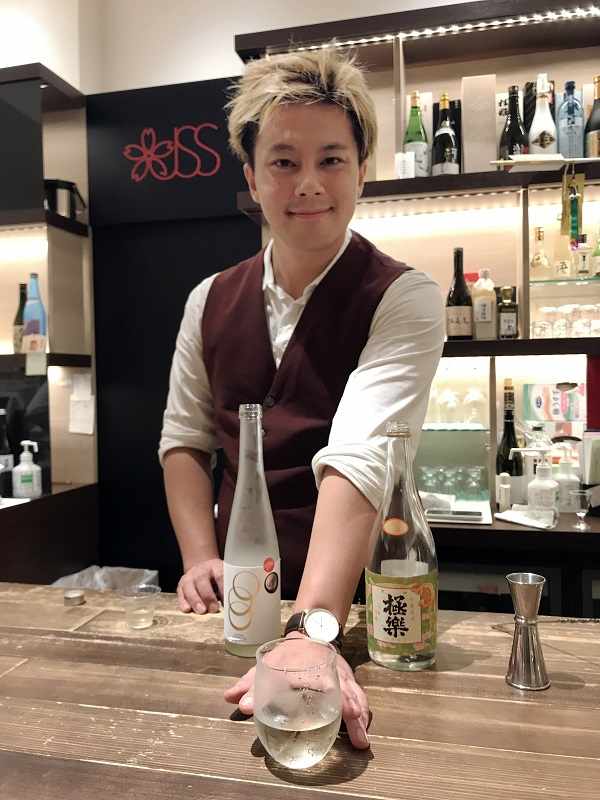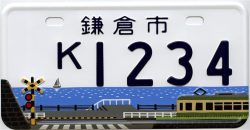
Japan Sake and Shochu Makers Association manager Yusuke Koike serves a yanagikage cocktail — an Edo-period luxury made with mirin and shochu — at the association’s headquarters in Tokyo on Sept. 13.
10:49 JST, September 26, 2022
A footnote drove me to drink mirin — and thereby travel back in time.
Mirin is a variant of sake, but these days it is used less as a beverage than as a kitchen ingredient that lends a touch of sweetness to many Japanese dishes. Many English-language dictionaries define it as a rice-based cooking wine.
But in the Edo period (1603-1867), mirin was for drinking, notably in a now almost forgotten cocktail called the yanagikage.
In 1938, the writer Koda Rohan published “Gendan” (The Pointer), a story in which a retired Edo samurai hires a guide to take him fishing. The pair spot a high-quality fishing pole floating in the water, seemingly lost by its owner. The tale takes a spooky turn when they row closer and find the pole is clutched in the hands of a drowned corpse.
In setting the scene, Koda mentions that refreshments on guided fishing trips often included yanagikage. An English translation of the story in the 2009 anthology “Kaiki: Uncanny Tales from Japan” has a footnote explaining that a yanagikage is a “cocktail of the sweet rice wine mirin and the distilled rice liquor shochu, popular in the Edo period as a summer beverage.”
Japanese ghost stories have long been popular summer entertainment for the “chill” they impart, and I began to hear that yanagikage was also served chilled. But how was that possible in the days before refrigeration?
I found the answer in another old story — this one from rakugo comedy. Titled “Aona” (Greens), it dates to around the middle of the Edo period.
After a gardener finishes some work for a wealthy homeowner, the appreciative client serves him sashimi, along with a bottle of yanagikage that has been chilled by lowering it into a well.
As they relax in the garden, the owner calls out to his wife to ask for a side dish of greens. The elegant lady appears in the doorway of the house and makes a short speech full of allusions to Japanese history. Her refined words are actually a punning way to inform her husband that they are out of vegetables.
The gardener is so impressed that he later plots with his own wife to put on a similar display for their neighbor, a carpenter. In contrast to the high-class homeowner’s cold yanagikage, the uncouth gardener serves his guest tepid sake. The story ends in comedic chaos when his wife, far from elegant, bursts out of a cobwebby closet and totally bungles her lines.
Searching for ingredients
“Yanagikage” literally translates as “shade of the willow tree,” which sounds both elegant and cool. It is also known as “honnaoshi.” Either away, I wanted to taste this intriguing two-ingredient drink.
Early this summer, I made an amateur yanagikage at home, using high-end cooking mirin (make sure it’s hon-mirin if you want to try this) and everyday shochu. The result was oddly minty, like a sweet mouthwash.
It wasn’t until mid-September that I tasted a yanagikage mixed by a professional, at a shochu media event hosted by the Japan Sake and Shochu Makers Association (JSS) at their Minato Ward, Tokyo, headquarters.
Mirin, like sake, is made from rice, but through a somewhat different process. Shochu can also be made from rice, but it is often based on ingredients such as sweet potatoes, barley or soba. Being distilled, shochu is stronger. According to JSS data, sake has an alcohol content of around 15%, while shochu’s is around 25%.
The mirin labels I have seen generally show figures around 14%.
Shuso Imada, the JSS general manager, explained at the event that shochu can be distilled in two different ways. Traditional distillation at ordinary atmospheric pressure yields a “powerful and complex” spirit, while a more modern method of distillation at reduced pressure yields one that is “gentle and fruity.”
JSS manager Yusuke Koike, the evening’s bartender, concocted a basic yanagikage with a 1-to-1 ratio of mirin and shochu. He used a low-pressure shochu of the Gokuraku brand from the Hayashi Sake Brewery in Kumamoto Prefecture. This brewery, according to its website, began making shochu in 1682.
The brand of mirin he used was called Me. It is available from Kanda Toshimaya Ltd., a company that traces its history all the way back to a drinking establishment that was set up on a bank of the Nihonbashi River in Edo in 1596.
Me is made specifically for drinking. Kanda Toshimaya CEO Rintaro Kimura describes Me as a koji liqueur — with koji being the all-important mold that breaks rice starch down into sugar in the first stages of the production of sake, shochu and mirin alike.
Kimura said his company aims for mirin to be globally recognized as the “third Japanese alcohol” after sake and shochu, and that Me has already won prizes as a liqueur in international beverage competitions.
The yanagikage that Koike made was sweet, but notably less syrupy than the one I had made. Its color was clear and its flavor was citrusy. He also made a second version with a third ingredient — a tonic — to moderate the sweetness and the alcohol content. Both versions were delicious.
On subsequent nights, I made two glasses of yanagikage at home, using two types of Fukumirin brand mirin from Fukumitsuya, a Kanazawa sake brewery founded in 1625, and sharp-scented Aka Kirishima sweet potato shochu from Miyazaki Prefecture-based Kirishima Shuzo Co., a relative newcomer with a history that dates back only to 1916.
A recipe on the Fukumitsuya website suggests a 1-to-2 ratio of mirin to shochu, served on the rocks. The dark reddish Fukumirin turned a milky yellow-green when mixed with the shochu. It had a sweet, faintly tangy taste that reminded me of green apples. The nearly black three-year-aged Fukumirin yielded a brown cocktail with a mellower flavor, like caramel or maple.
Clearly there is a great deal of enjoyable experimentation waiting to be done in the yanagikage field.
I’m just glad that I can make a cold drink with ice cubes from my freezer rather than lowering a bottle down a well — or lowering it over the side of a fishing boat. Koda’s story would have me wondering what spooky things the bottle might encounter down in those cold, dark depths.
Talk about chilled spirits. Kampai!
"JN Specialities" POPULAR ARTICLE
-

English-language Kabuki, Kyogen Entertain Audiences in Tokyo; Portland State University Professor Emeritus, Graduates Perform
-

The Japan News / Weekly Edition (11/14-11/20)
-

Yomiuri International Cooperation Prize: Prize fosters future generations of professionals
-

Tokyo’s Biggest Exhibit on Donald Keene Set to Open Saturday at Setagaya Literary Museum; Many Pieces to Be Displayed for 1st Time
-

Noodle Dining Shunsai / Rich Oyster Ramen to Savor at Odasaga; Experienced 68-year-old Owner Creates Numerous Ramen Varieties
JN ACCESS RANKING
-

Govt Plans to Urge Municipalities to Help Residents Cope with Rising Prices
-

Japan Resumes Scallop Exports to China
-

Japan Prime Minister Takaichi Vows to Have Country Exit Deflation, Closely Monitor Economic Indicators
-

Japan to Charge Foreigners More for Residence Permits, Looking to Align with Western Countries
-

JR East Suica’s Penguin to Retire at End of FY2026; Baton to be Passed to New Character






















